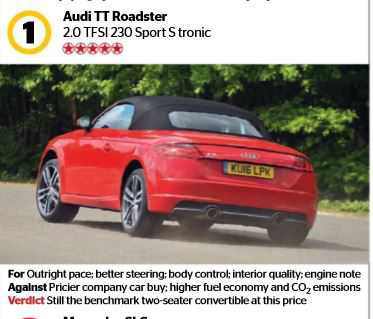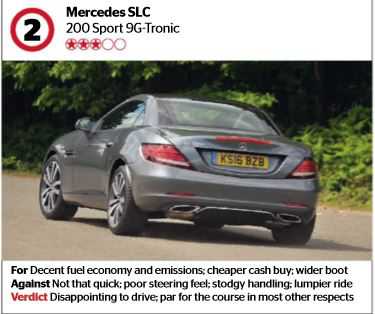The kings of summer Audi TT vs. Mercedes-Benz SLC
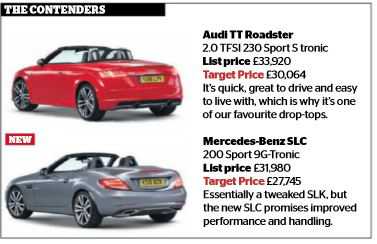
What are they like to drive? The SLC’s 2.0-litre petrol engine is gutsy enough. Acceleration starts to pick up from around 1700rpm, although it never really excites. The TT is much faster. Its 2.0-litre motor doesn’t come on song until around 2000rpm, but from then on it’s punchier and shows the Mercedes a clean pair of heels. So, despite the rear-wheel-drive Mercedes having better traction away from the line, the front-wheeldrive Audi still races from 0-60mph in an impressive 6.3sec – 0.8sec quicker than its rival. It’s also better at overtaking, clocking a 2.0sec advantage from 30-70mph. We’re testing both cars with optional automatic gearboxes. While the SLC’s has the advantage of nine gears to the TT’s six, the Audi reacts more quickly when you press the accelerator and it produces snappier changes thereafter. The SLC’s gearbox is a touch more lethargic by comparison, although both cars shift smoothly when you’re just mooching about. In theory, the SLC’s rear-wheeldrive layout should serve up more playful handling, but the reality is somewhat different.

It’s less planted than its rival on rougher roads, hopping over mid-corner bumps that the TT rides with ease, and the SLC’s steering also offers little feedback on how well the front wheels are gripping the road. The SLC can also feel quite keen to swap ends if you’re too eager with the accelerator pedal on damp roads, although the stability control system always cuts in to prevent this from happening. Put simply, the SLC is a car best enjoyed at a more leisurely pace. In contrast, the TT eggs you on. There’s much more grip so you can carry much more speed in to corners, and as you turn in, its steering weights up with greater consistency than the SLC’s, filling you with confidence. There’s also less body lean, and when you do finally reach the TT’s limits the steering quickly streams that information to your fingertips. Simply backing off the accelerator pedal brings everything neatly back in to line. The TT also has stronger brakes and its firmer brake pedal is more confidence-inspiring. Although both cars have a stiff ride, the SLC is slightly less fidgety over lightly rippled roads. However, when the surface gets really craggy the TT – even with our test car’s stiffer S line suspension and larger 18in wheels – does a better job of taking the edge off sharp potholes, and its more rigid chassis allows less shuddering to be transmitted through the car’s body. While the SLC’s engine is quite smooth, it sounds decidedly ordinary for a sports car. Put your foot down in the TT and you get a sportier exhaust note accompanied by loud barks between gear changes that add an extra degree of excitement. When you’re cruising on the motorway, the SLC’s folding metal roof is better at keeping road noise out of the cabin than the TT’s canvas hood, but there’s more wind noise in the Mercedes. When you want alfresco fun, the SLC’s clever but complicated electric roof takes 20sec to fold down – twice as long as the TT’s. Both are accomplished open-topped cruisers that keep you largely bluster free at motorway speeds, as long as you have their wind defl ectors in place. As standard you get a slot-in fabric defl ector on the SLC. The TT’s is more elaborate and can be raised or lowered electrically at the touch of a button, but it’s a pricey £425 option.
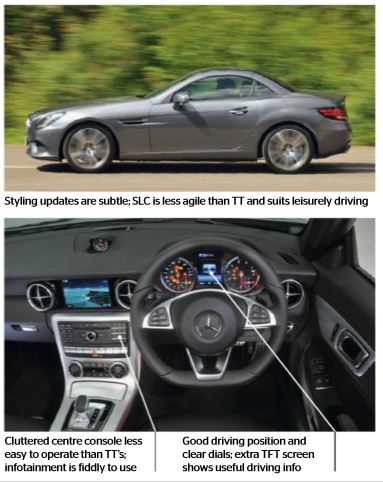
What are they like inside? Both cars offer plenty of room for two tall adults along with fi ne driving positions, thanks to comfortable seats and lots of steering wheel adjustment. However, it’s a shame that neither car has adjustable lumbar support. The TT’s interior feels more upmarket than the SLC’s. Its switches click with more precision, and while both interiors have plenty of soft-touch surfaces, the Audi’s feel plusher. Everything in the TT seems better screwed together, too, because there are far fewer creaks and squeaks from the trim and dash on bumpy roads. You have to pay extra to get sat-nav in both cars. It’s more reasonably priced in the SLC (£595 versus £1490), but the SLC’s infotainment system isn’t as intuitive as the TT’s and makes do with a relatively small 7.0in screen in the centre of the dashboard. The TT gets a 12.3in screen that is mounted directly behind the steering wheel – something Audi calls a Virtual Cockpit. It puts all the infotainment functions, including sat-nav maps and radio stations, closer to your line of sight, and the whole system is remarkably easy to get used to. The SLC has more interior stowage space, though, including a bigger glovebox and deeper cubby under the centre armrest. It also has a slightly bigger boot when the roof is up. So, while the TT will carry a couple of overnight bags, the SLC should manage a third and, thanks to its wider opening, it’s also capable of carrying bulkier items. The catch is that the SLC’s boot almost halves in size when you drop the hood, so for roofdown load lugging the TT is the more practical of the two.
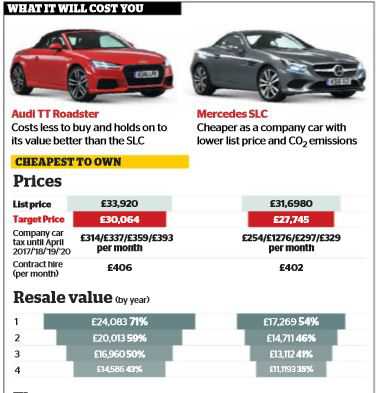
What will they cost? The SLC is neither as good to drive as the TT nor as nice inside, but it is at least cheaper to buy. It’ll cost you £2319 less of your hard-earned cash if you’re prepared to haggle. Of course, it isn’t just upfront costs you need to worry about, and over a three-year period it’s the TT that works out cheaper. That’s mainly because of its slower depreciation, but also because it’s cheaper to insure and service. Looking at offi cial fuel economy claims, the SLC will average almost 5.0mpg more than the TT. That difference tots up to around £500 in fuel over 36,000 miles. For those who prefer to buy their car with fi nance, Audi charges £347 a month on a 30,000-mile, three-year PCP agreement with a £5000 deposit. Mercedes demands £370 a month on the same terms. The SLC is the more appealing car for company car drivers. The combination of its lower CO2 emissions and cheaper list price mean you’ll sacrifi ce around £2200 less of your salary in benefi t-in-kind (BIK) tax over three years, assuming you’re a 40% rate tax payer. Meanwhile, straightforward leasing costs are similar on both cars, at around £400 per month. Both of these drop-tops come with alloys, a DAB radio, Bluetooth, and cruise control; beyond that their specifi cations are surprisingly miserly. You need to pay extra for automatic lights and wipers, metallic paint and climate control. Mercedes charges £250 for Apple CarPlay smartphone integration, but this isn’t available on the TT. The small rear screens on both cars badly restrict rear visibility, so we’d certainly suggest adding a reversing camera or parking sensors. Audi charges £430 for rear sensors alone, while Mercedes bundles them in a package with front sensors and a self-parking system for £675. Only the TT has been crash tested by Euro NCAP, scoring four stars out of a possible fi ve. Both cars come with six airbags, but you also get automatic emergency braking on the SLC. Disappointingly, this isn’t available as on option on the TT.
*OUR VERDICT
The new SLC isn’t the marked improvement over the old SLK we’d hoped for, but it has some appeal. It’s relatively practical, has the security of a folding metal roof and the obvious kudos of a MercedesBenz badge. It’s just a shame it’s so underwhelming to drive. In comparison, the TT is a class act. It’s fabulous to drive, stunning inside and easy to live with – and it’s also cheaper if you’re buying on fi nance or paying upfront. It’s one of the best drop-tops on sale.
